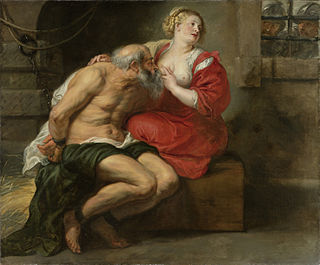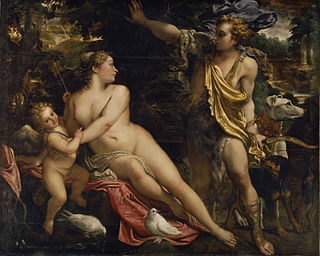
The Museo del Prado, officially known as Museo Nacional del Prado, is the main Spanish national art museum, located in central Madrid. It houses collections of European art, dating from the 12th century to the early 20th century, based on the former Spanish royal collection, and the single best collection of Spanish art. Founded as a museum of paintings and sculpture in 1819, it also contains important collections of other types of works. The numerous works by Francisco Goya, the single most extensively represented artist, as well as by Hieronymus Bosch, El Greco, Peter Paul Rubens, Titian, and Diego Velázquez, are some of the highlights of the collection. Velázquez and his keen eye and sensibility were also responsible for bringing much of the museum's fine collection of Italian masters to Spain, now one of the largest outside of Italy.

Gaspar de Crayer or Jasper de Crayer was a Flemish painter known for his many Counter-Reformation altarpieces and portraits. He was a court painter to the governors of the Southern Netherlands and worked in the principal cities of Flanders where he helped spread the Rubens style.

Roman Charity or Cimon and Pero is an ancient Greek and Roman exemplary story of filial piety in which a woman secretly breastfeeds her father or mother, incarcerated and supposedly sentenced to death by starvation. Once caught, the loving devotion shown so moves the authorities that she is forgiven and the parent is typically freed. The father in the story is often named Cimon and the daughter Pero, although other versions name the father Mycon. First attested in surviving Roman sources, it became a common theme in Early Modern period of Western European art, particularly the Baroque period.
Erotic lactation is sexual arousal by sucking on a female or male breast. Depending on the context, the practice can also be referred to as adult suckling, adult nursing, and adult breastfeeding. Practitioners sometimes refer to themselves as being in an adult nursing relationship (ANR). Two persons in an exclusive relationship can be called a nursing couple

Gaspar de Guzmán, Count-Duke of Olivares, on Horseback is an oil on canvas painting by Spanish painter Diego Velázquez, made around the year 1636. It has been in the Museo del Prado in Madrid since its inauguration in 1819.

Willem van Herp (I) or Willem van Herp the Elder (variations on first name: 'Guilliam', 'Gilliam' and 'Guillaume') (c. 1614 in Antwerp – 1677) was a Flemish Baroque painter specializing in religious paintings and small cabinet paintings of "low-life" genre scenes. He operated a large workshop and through his good connections with Antwerp art dealers helped spread the Flemish Baroque style internationally.

Apollo in the Forge of Vulcan, sometimes referred to as Vulcan's Forge, is an oil painting by Diego de Velázquez completed after his first visit to Italy in 1629. Critics agree that the work should be dated to 1630, the same year as his companion painting Joseph's Tunic. It appears that neither of the two paintings were commissioned by the king, although both became part of the royal collections within a short time. The painting became part of the collection of the Museo del Prado, in Madrid, in 1819.

The Death of Cleopatra, also known simply as Cleopatra, is an 1881 oil painting on canvas by the Filipino painter Juan Luna, currently on display at the Museo del Prado in Madrid, Spain. Depicting the death of Cleopatra, the last active ruler of ancient Egypt, the painting was painted during Luna's stay in Rome, and later won a silver medal during the 1881 National Exposition of Fine Arts in Madrid, which was also his first art exposition.

The Worship of Venus is an oil on canvas painting by the Italian artist Titian completed between 1518 and 1519, housed at the Museo del Prado in Madrid, Spain. It describes a Roman rite of worship conducted in honour of the goddess Venus each 1 April. On this occasion, women would make offerings to representations of the goddess so as to cleanse "every blemish on their bodies".

Venus, Adonis and Cupid is a painting created c. 1595 by Annibale Carracci. The painting is in the Museo del Prado, Madrid. Annibale Carracci was one of the most well known Italian Baroque painters of the seventeenth century. The Carracci brothers established an academy of art called Accademia degli Incamminati, which pioneered the development of Bolognese Painting. Annibale Carracci and Caravaggio were among the most influential artists of this century, who through their unique artistic styles led to the transition from Mannerist to Baroque. Annibale was born in Bologna in 1560 and died in Rome in 1609.

The Birth of the Milky Way, also sometimes known as The Origin of the Milky Way, is an oil-on-canvas painting by the Flemish artist Peter Paul Rubens, produced between 1636 and 1638 and featuring the Greco-Roman myth of the origin of the Milky Way. The painting depicts Hera (Juno), spilling her breast milk, the infant Heracles (Hercules) and Zeus (Jupiter) in the background, identifiable by his eagle and lightning bolts. Hera's face is modelled on Rubens' wife, Hélène Fourment. The carriage is pulled by peacocks, a bird which the ancient Greeks and Romans considered sacred to both themselves and to Hera/Juno, as a result of their ability to signal changes in weather through cries and hence their perceived connection to the gods.

The Rape of Ganymede is a painting by the Flemish Baroque painter Peter Paul Rubens produced between 1636 and 1638 painting for the Spanish king Philip IV of Spain's hunting lodge. The painting is based on a story recounted in classical poet Ovid's Metamorphoses. It depicts the moment when the Roman supreme god Jupiter disguised as an eagle catches the young shepherd Ganymede and lifts him into the air. It is in the collection of the Museo del Prado in Madrid. The dramatic scene gave Rubens ample opportunity to show his skill in depicting a lively scene and the nude.

The Adoration of the Magi is a very large oil painting by the Flemish Baroque painter Peter Paul Rubens. He first painted it in 1609 and later gave it a major reworking between 1628 and 1629 during his second trip to Spain. It is now in the Museo del Prado in Madrid.

Roman Charity is an oil on canvas painting by Peter Paul Rubens, executed c. 1612, now in the Hermitage Museum, in Saint Petersburg, for which it was bought from Koblenz's collection in Brussels in 1768. In 1828 D. A. Smitha of the Hermitage misattributed it as a copy. Later researchers agreed in 1864 and the work was placed in store until 1905, when a re-examination restored its autograph status.

Caritas Romana is an oil on canvas painting by Flemish painter Gaspar de Crayer. The painting was part of the Jan De Maere Gallery's collection up to 2003, and is today owned by a unknown collector. According to some sources, it was at the Dorotheum in 2007.

Landscape with Sea and Mountain is an oil-on-canvas painting by Flemish painter Joos de Momper. It was painted in the early 1620s, and is now in the Museum of Prado in Madrid.

Excursion in the Countryside of Infanta Isabel Clara Eugenia is an oil on canvas painting by Flemish artists Jan Brueghel the Elder and Joos de Momper. It was painted in the first quarter of the 17th century, and is housed at the Museum of Prado, in Madrid.

Life in the Countryside is an oil on canvas painting by Flemish artists Jan Brueghel the Elder and Joos de Momper. It was painted between 1620 and 1622. The painting is kept in the Museum of Prado in Madrid.

Landscape with Skater is an oil on canvas painting by Flemish artist Joos de Momper. The painting is today considered a collaboration between the latter and Jan Brueghel the Elder. It was painted between 1615 and 1625. The painting is kept in the Museum of Prado in Madrid.

Alpine Landscape is an oil-on-canvas painting by Flemish painter Tobias Verhaecht. The painting was completed between 1600 and 1615, and is now in the Museum of Prado in Madrid.



















